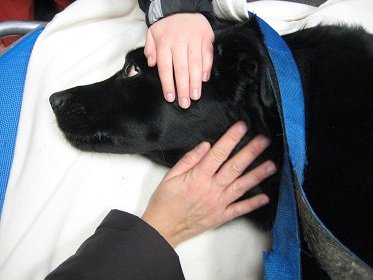Shaking is always a reaction to something going on in a body. whenever you notice your diabetic dog shaking, pay attention. It could be an indication of a serious illness in the body.

Reasons Diabetic dog is shaking?
Shaking could be due to various reasons. It could be as simple as some emotional trauma going on in the body or an indication of an emergency like ketoacidosis or hyperglycemia in a diabetic dog’s body.
The reasons why the diabetic dog is shaking includes
- Fear or trauma
- Cold
- Overdose of insulin
- Missed dose of insulin
- Low insulin levels
Fear or trauma
Fear is anyway not a good thing. In diabetes, emotional balance is as important as physical health. Fear can trigger hormones in a body that can cause insulin imbalance making the diabetic situation worse.
Try not to leave the dog alone or find the reason why your dog is scared. Overcoming fear can help with shivering and shaking.
Cold
Your diabetic dog may be shaking due to a cold. Dogs can catch a cold when they stay wet for a long time. Mostly this happens when dogs stay out in the rain. We advise don’t leave your dog unassisted in the rain for longer periods.
In diabetes, usually, the healing powers of the body slow down. So better not to mess in the first place.
Read our article Why does my dog stay out in rain to further understand the consequences.
Overdose of insulin
Diabetic dog shaking can be a symptom of too much insulin in the body. Insulin is given to managing diabetes in dogs. Your dog must receive insulin at regular intervals and only in the required dosage. The overdose of insulin can cause hypoglycemia which is caused by low blood sugar.
The science behind it
Insulin converts glucose into energy. This keeps glucose levels normal in the bloodstream. More insulin in the body means more glucose is turned into energy. This leaves the bloodstream with low sugar levels.
In hypoglycemia, blood glucose levels can drop down to dangerously low levels. If not treated on time, it can be fatal to your dog. The symptoms of hypoglycemia include
- Weakness
- Panting
- Shaking
- Faintness
- Seizures
- Coma
If your dog is suffering from hypoglycemia, it will also make your diabetic dog restless at night. He may yelp also or scratch carpet out of nowhere.
Missed dose of insulin
A missed dose of insulin can trigger diabetes symptoms for a short time. A dog can experience
- Shaking or trembling
- frequent urination and
- excessive thirst
As temporary symptoms. With the next dose, the symptoms will start wearing off.
Ketoacidosis
When blood glucose level remains low for a large period, it can cause ketoacidosis. It is important to give insulin to your dog regularly. When you miss several doses or insulin levels in a dog’s body fall due to other reasons, ketoacidosis can happen. The condition can last for days starting from simple symptoms. If not treated, it can lead to death in dogs. Symptoms of ketoacidosis include
- Shivering
- Shaking
- Diarrhea (read our article diabetic dog diarrhea)
- Vomiting
- Heart palpations
- Rapid breathing
- Drooling
- Organ failure
- Uncoordinated body movements
- Brain damage
Never give insulin when your dog is having severe ketoacidosis. It can worsen the condition. It is advised to treat and make the condition stable before injecting insulin to dogs having ketoacidosis. (Read our article dog injection sites)
Hyperglycemia
Hyperglycemia happens when blood glucose levels go high than normal. (Read our article glucose level 500). Mostly this happens when there is low insulin in the body and body metabolism is unable to convert sugar to energy.
Hyperglycemia can cause
- Blurred vision
- Vomiting
- Panting
- Increased heart rate and
- Shaking
What to do if your diabetic dog is shaking?
Shaking is odd, weird, and dangerous for diabetic dogs. When you notice your diabetic dog is shaking,
Check the glucose levels
Monitoring glucose levels is important. This is the first step to make your dog better. Knowing the reason will help you in making quick decisions. Always maintain a regular record of your dog’s glucose level in a glucose chart.
However, as sudden excitement or fear can mess with insulin activity within minutes so glucose levels will help you to determine the real cause of shaking. Also, maintaining regular records usually prevents your dog from going into situations like ketoacidosis.
Treat your dog in an emergency
If the blood glucose level is too high or low, you need to treat your dog urgently. If the glucose levels are high you may need to give insulin to your dog and if they are low, rub corn syrup on dogs’ gums. Acting on time can save your dog’s life.
Set long term goals
Insulin is not the only solution to diabetes. It’s important to treat diabetic dogs without insulin too. Other factors play important role in managing diabetes.
- Your dog will stay fit only if he will follow a proper diet and exercise regimen.
- Try to feed him daily at the same time.
- Insulin must be given to dogs after meals.
- Take proper care of the exercise and physical activities of the dog.
With a healthy lifestyle, you can manage your dog’s diabetes better.
Is shaking the final stages of dog diabetes?
This depends.
Let’s talk about it step by step
- If you don’t know yet that your dog has diabetes and your dog is shaking, we recommend getting your dog checked for diabetes. Usually, the first symptoms of diabetes are shaking, panting, and excessive thrust.
- When you know your dog has diabetes, and your dog is shaking, monitor glucose levels. Missed dose means the symptoms will go away and nothing to worry about. In case of overdose, shaking could be an indication of an emergency.
- Whether you know or don’t know, if your dog has diabetes and is missing insulin for a long time, he may suffer ketoacidosis. If the dog will not get treatment, the body organs will start shutting down.
- Sometimes shaking is just a light shiver that can be treated by treating the cause. However, it could also be an emergency and sometimes the final stage of diabetes too. When the dog is having seizures, he may have shaking movements. Seizures cause brain death, coma, and eventually death.
So It’s important to treat diabetic dog shaking at the first step.
When to put a diabetic dog down?
This is a hard decision. Managing diabetes is not tough but when things are critical it’s better to let go of your pup. In case, your diabetic dog is serious for example
- He had seizures or is in a coma,
- His Organs are failing
- there is no coming back and
- The dog’s suffering will continue if not eradicated
it’s better to give your dog euthanasia.
Conclusion
A diabetic dog shaking can be an indication of many things. In case of hypoglycemia or ketoacidosis, your dog must be treated on an emergency basis. If things go out of hand, it can lead to the dog’s death.

